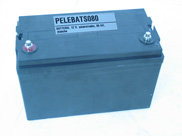BATTERY stationary, lead-acid, 12V/80Ah, sealed
Valid Article
BATTERY, stationary, 12V, solar/radio/backup
Definition
A sealed and rechargeable battery. A sealed battery does not contain any liquid electrolyte and is maintenance free for life time. It ensures high discharge flows and deep cyclic use.
Two types of lead-acid batteries are used within MSF:
- STARTER batteries, which are intended for cars, trucks and generators.
- STATIONARY or SOLAR or SEMI-TRACTION batteries, which are intended for radio rooms, solar installations, UPS and emergency backup systems.
Specifications
- Stationary batteries produce a lower current than starter batteries, but they continue to deliver energy until they are deeply discharged without being damaged.
- They are SEALED lead-acid batteries which contain (gel) electrolyte and are ready to use. They are not sensitive to humidity or movement, do not spill and are maintenance-free.
As a rule in MSF we do not discharge lead batteries beyond 50% of their capacity (referred to as d.o.d. or depth of discharge) in order to extend the lifespan of the battery. Therefore for our calculations, we consider that an 80 Ah battery has 40 Ah of usable capacity.
To increase the capacity, you can connect batteries in parallel, provided they are identical (same type, same capacity, same age). The connection must be made with 25 mm² cable.
Ask your technical department for a tool to help calculate the battery capacity needed.
Transport Dangerous Goods
UN2800: special provisions in air (A67) and sea (238) that allow us to send the product as not subject to regulation.
You need to prove that batteries have past vibration test, pressure differential test and leakage test. These tests should be mentioned on the MSDS or on additional documentation.
Instructions for use
General recommendations:
- Never use a stationary battery for a vehicle.
- Never use a starter battery for stationary applications (radio etc.).
- Do not expose batteries to the sun. Place the batteries in the coolest and well ventilated place.
- When connecting the battery be careful to maintain the correct polarity!
- In general, the RED cable is connected to the "+" terminal and the BLACK cable to the "-" terminal.
Charging batteries:
- If batteries have not been used for a long time, you are recommended to charge them for at least 2 hours before use.
- The charging current for a sealed battery can be up to 20% of its capacity. Don't charge with higher currents.
- If available, use an "automatic" charger with 3-step charge management and temperature sensor.
- Batteries should be stored charged.
- Even when not used, they should be charged at least every 6 months.
More info on Sherlog:
Lead Acid Batteries : How to calculate the life expectancy and required size for a battery bank : https://sherlog.msf.org/articles/2166/lead-acid-batteries-how-to-calculate-the-life-expe.html


![[ELAEMBIE1--] REAL-TIME PCR SYSTEM (GeneXpert GX-IV), 4 mod. 6col+computer](/web/image/product.template/572483/image_256/%5BELAEMBIE1--%5D%20REAL-TIME%20PCR%20SYSTEM%20%28GeneXpert%20GX-IV%29%2C%204%20mod.%206col%2Bcomputer?unique=f8bca10)
![[ELAEMBIE11-] REAL-TIME PCR SYSTEM (GeneXpert GX-IV), 4 mod. 6 col+ laptop](/web/image/product.template/569294/image_256/%5BELAEMBIE11-%5D%20REAL-TIME%20PCR%20SYSTEM%20%28GeneXpert%20GX-IV%29%2C%204%20mod.%206%20col%2B%20laptop?unique=2160dde)
![[PELEBATTSBN-] BATTERY CLAMP, negative pole](/web/image/product.template/553091/image_256/%5BPELEBATTSBN-%5D%20BATTERY%20CLAMP%2C%20negative%20pole?unique=d41eaba)
![[PELEBATTSBP] BATTERY CLAMP (positive pole) M8 nut, MAN type](/web/image/product.template/555070/image_256/%5BPELEBATTSBP%5D%20BATTERY%20CLAMP%20%28positive%20pole%29%20M8%20nut%2C%20MAN%20type?unique=063e095)
![[PELEMEASMWC] MULTIMETER, AC/DC + ampere clamp meter](/web/image/product.template/550155/image_256/%5BPELEMEASMWC%5D%20MULTIMETER%2C%20AC-DC%20%2B%20ampere%20clamp%20meter?unique=e914752)
![[TVEMBATTC27] CABLE SET parallel installation 2 batteries, for HZJ7#](/web/image/product.template/554497/image_256/%5BTVEMBATTC27%5D%20CABLE%20SET%20parallel%20installation%202%20batteries%2C%20for%20HZJ7%23?unique=fb7c873)
![[KPROMPOS100] MODULE, POWER SUPPLY 230/12/230V, 1500VA char./inv. + batt.](/web/image/product.template/550855/image_256/%5BKPROMPOS100%5D%20MODULE%2C%20POWER%20SUPPLY%20230-12-230V%2C%201500VA%20char.-inv.%20%2B%20batt.?unique=cc3a103)